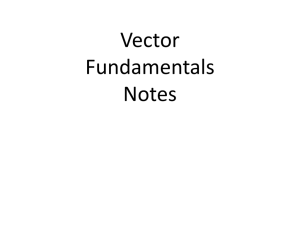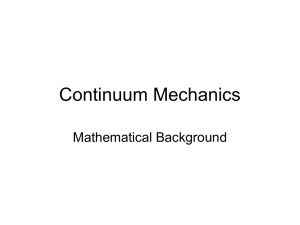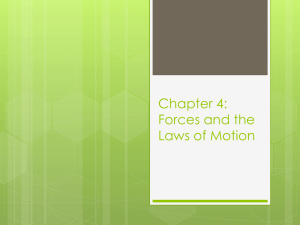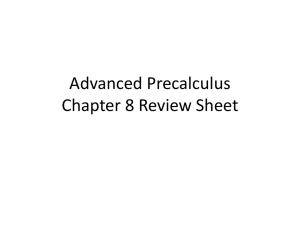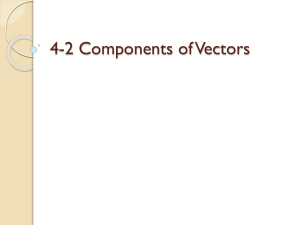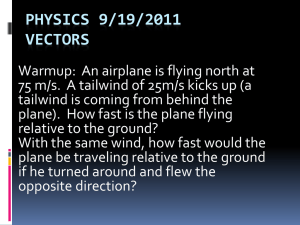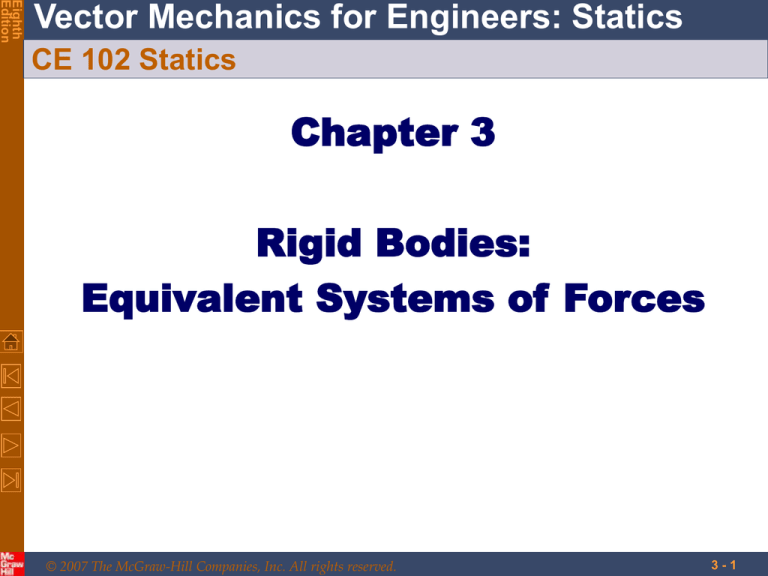
Eighth
Edition
Vector Mechanics for Engineers: Statics
CE 102 Statics
Chapter 3
Rigid Bodies:
Equivalent Systems of Forces
© 2007 The McGraw-Hill Companies, Inc. All rights reserved.
3-1
Eighth
Edition
Vector Mechanics for Engineers: Statics
Contents
Introduction
Moment of a Force About a Given Axis
External and Internal Forces
Sample Problem 3.2
Principle of Transmissibility: Equivalent
Forces
Moment of a Couple
Vector Products of Two Vectors
Couples Can Be Represented By Vectors
Moment of a Force About a Point
Resolution of a Force Into a Force at O and a
Couple
Varigon’s Theorem
Rectangular Components of the Moment
of a Force
Addition of Couples
Sample Problem 3.3
Sample Problem 3.1
System of Forces: Reduction to a Force and a
Couple
Scalar Product of Two Vectors
Further Reduction of a System of Forces
Scalar Product of Two Vectors:
Applications
Sample Problem 3.4
Sample Problem 3.5
Mixed Triple Product of Three Vectors
© 2007 The McGraw-Hill Companies, Inc. All rights reserved.
3-2
Eighth
Edition
Vector Mechanics for Engineers: Statics
Introduction
• Treatment of a body as a single particle is not always possible. In
general, the size of the body and the specific points of application of the
forces must be considered.
• Most bodies in elementary mechanics are assumed to be rigid, i.e., the
actual deformations are small and do not affect the conditions of
equilibrium or motion of the body.
• Current chapter describes the effect of forces exerted on a rigid body and
how to replace a given system of forces with a simpler equivalent system.
• moment of a force about a point
• moment of a force about an axis
• moment due to a couple
• Any system of forces acting on a rigid body can be replaced by an
equivalent system consisting of one force acting at a given point and one
couple.
© 2007 The McGraw-Hill Companies, Inc. All rights reserved.
3-3
Eighth
Edition
Vector Mechanics for Engineers: Statics
External and Internal Forces
• Forces acting on rigid bodies are
divided into two groups:
- External forces
- Internal forces
• External forces are shown in a
free-body diagram.
• If unopposed, each external force
can impart a motion of
translation or rotation, or both.
© 2007 The McGraw-Hill Companies, Inc. All rights reserved.
3-4
Eighth
Edition
Vector Mechanics for Engineers: Statics
Principle of Transmissibility: Equivalent Forces
• Principle of Transmissibility Conditions of equilibrium or motion are
not affected by transmitting a force
along its line of action.
NOTE: F and F’ are equivalent forces.
• Moving the point of application of
the force F to the rear bumper
does not affect the motion or the
other forces acting on the truck.
• Principle of transmissibility may
not always apply in determining
internal forces and deformations.
© 2007 The McGraw-Hill Companies, Inc. All rights reserved.
3-5
Eighth
Edition
Vector Mechanics for Engineers: Statics
Vector Product of Two Vectors
• Concept of the moment of a force about a point is
more easily understood through applications of
the vector product or cross product.
• Vector product of two vectors P and Q is defined
as the vector V which satisfies the following
conditions:
1. Line of action of V is perpendicular to plane
containing P and Q.
2. Magnitude of V is V PQ sin
3. Direction of V is obtained from the right-hand
rule.
• Vector products:
- are not commutative, Q P P Q
- are distributive,
P Q1 Q2 P Q1 P Q2
- are not associative, P Q S P Q S
© 2007 The McGraw-Hill Companies, Inc. All rights reserved.
3-6
Eighth
Edition
Vector Mechanics for Engineers: Statics
Vector Products: Rectangular Components
• Vector products of Cartesian unit vectors,
i i 0
j i k k i j
i j k
j j 0
k j i
i k j j k i
k k 0
• Vector products in terms of rectangular
coordinates
V Px i Py j Pz k Qx i Q y j Qz k
Py Qz Pz Q y i Pz Qx Px Qz j
Px Q y Py Qx k
i
j
k
Px Py Pz
Qx Q y Qz
© 2007 The McGraw-Hill Companies, Inc. All rights reserved.
3-7
Eighth
Edition
Vector Mechanics for Engineers: Statics
Moment of a Force About a Point
• A force vector is defined by its magnitude and
direction. Its effect on the rigid body also depends
on it point of application.
• The moment of F about O is defined as
MO r F
• The moment vector MO is perpendicular to the
plane containing O and the force F.
• Magnitude of MO measures the tendency of the force
to cause rotation of the body about an axis along MO.
M O rF sin Fd
The sense of the moment may be determined by the
right-hand rule.
• Any force F’ that has the same magnitude and
direction as F, is equivalent if it also has the same line
of action and therefore, produces the same moment.
© 2007 The McGraw-Hill Companies, Inc. All rights reserved.
3-8
Eighth
Edition
Vector Mechanics for Engineers: Statics
Moment of a Force About a Point
• Two-dimensional structures have length and breadth but
negligible depth and are subjected to forces contained in
the plane of the structure.
• The plane of the structure contains the point O and the
force F. MO, the moment of the force about O is
perpendicular to the plane.
• If the force tends to rotate the structure clockwise, the
sense of the moment vector is out of the plane of the
structure and the magnitude of the moment is positive.
• If the force tends to rotate the structure counterclockwise,
the sense of the moment vector is into the plane of the
structure and the magnitude of the moment is negative.
© 2007 The McGraw-Hill Companies, Inc. All rights reserved.
3-9
Eighth
Edition
Vector Mechanics for Engineers: Statics
Varignon’s Theorem
• The moment about a give point O of the
resultant of several concurrent forces is equal
to the sum of the moments of the various
moments about the same point O.
r F1 F2 r F1 r F2
• Varigon’s Theorem makes it possible to
replace the direct determination of the
moment of a force F by the moments of two
or more component forces of F.
© 2007 The McGraw-Hill Companies, Inc. All rights reserved.
3 - 10
Eighth
Edition
Vector Mechanics for Engineers: Statics
Rectangular Components of the Moment of a Force
The moment of F about O,
M O r F , r xi yj zk
F Fx i Fy j Fz k
M O M xi M y j M z k
i
x
Fx
j
y
Fy
k
z
Fz
yFz zFy i zFx xFz j xFy yFx k
© 2007 The McGraw-Hill Companies, Inc. All rights reserved.
3 - 11
Eighth
Edition
Vector Mechanics for Engineers: Statics
Rectangular Components of the Moment of a Force
The moment of F about B,
M B rA / B F
rA / B rA rB
x A xB i y A y B j z A z B k
F Fx i Fy j Fz k
i
M B x A xB
Fx
j
k
y A yB z A z B
Fy
Fz
© 2007 The McGraw-Hill Companies, Inc. All rights reserved.
3 - 12
Eighth
Edition
Vector Mechanics for Engineers: Statics
Rectangular Components of the Moment of a Force
For two-dimensional structures,
M O xFy yFx k
MO MZ
xFy yFx
M B x A xB Fy y A yB Fx k
MB MZ
x A xB Fy y A yB Fx
© 2007 The McGraw-Hill Companies, Inc. All rights reserved.
3 - 13
Eighth
Edition
Vector Mechanics for Engineers: Statics
Sample Problem 3.1
A 100-lb vertical force is applied to the end of a
lever which is attached to a shaft at O.
Determine:
a) moment about O,
b) horizontal force at A which creates the same
moment,
c) smallest force at A which produces the same
moment,
d) location for a 240-lb vertical force to produce
the same moment,
e) whether any of the forces from b, c, and d is
equivalent to the original force.
© 2007 The McGraw-Hill Companies, Inc. All rights reserved.
3 - 14
Eighth
Edition
Vector Mechanics for Engineers: Statics
Sample Problem 3.1
a) Moment about O is equal to the product of the
force and the perpendicular distance between the
line of action of the force and O. Since the force
tends to rotate the lever clockwise, the moment
vector is into the plane of the paper.
M O Fd
d 24 in. cos 60 12 in.
M O 100 lb 12 in.
© 2007 The McGraw-Hill Companies, Inc. All rights reserved.
M O 1200 lb in
3 - 15
Eighth
Edition
Vector Mechanics for Engineers: Statics
Sample Problem 3.1
b) Horizontal force at A that produces the same
moment,
d 24 in. sin 60 20.8 in.
M O Fd
1200 lb in. F 20.8 in.
1200 lb in.
F
20.8 in.
© 2007 The McGraw-Hill Companies, Inc. All rights reserved.
F 57.7 lb
3 - 16
Eighth
Edition
Vector Mechanics for Engineers: Statics
Sample Problem 3.1
c) The smallest force A to produce the same moment
occurs when the perpendicular distance is a
maximum or when F is perpendicular to OA.
M O Fd
1200 lb in. F 24 in.
F
© 2007 The McGraw-Hill Companies, Inc. All rights reserved.
1200 lb in.
24 in.
F 50 lb
3 - 17
Eighth
Edition
Vector Mechanics for Engineers: Statics
Sample Problem 3.1
d) To determine the point of application of a 240 lb
force to produce the same moment,
M O Fd
1200 lb in. 240 lb d
1200 lb in.
5 in.
240 lb
OB cos60 5 in.
d
© 2007 The McGraw-Hill Companies, Inc. All rights reserved.
OB 10 in.
3 - 18
Eighth
Edition
Vector Mechanics for Engineers: Statics
Sample Problem 3.1
e) Although each of the forces in parts b), c), and d)
produces the same moment as the 100 lb force, none
are of the same magnitude and sense, or on the same
line of action. None of the forces is equivalent to the
100 lb force.
© 2007 The McGraw-Hill Companies, Inc. All rights reserved.
3 - 19
Eighth
Edition
Vector Mechanics for Engineers: Statics
Sample Problem 3.2
SOLUTION:
The moment MA of the force F exerted
by the wire is obtained by evaluating
the vector product,
M A rC A F
The rectangular plate is supported by
the brackets at A and B and by a wire
CD. Knowing that the tension in the
wire is 200 N, determine the moment
about A of the force exerted by the
wire at C.
© 2007 The McGraw-Hill Companies, Inc. All rights reserved.
3 - 20
Eighth
Edition
Vector Mechanics for Engineers: Statics
Sample Problem 3.2
SOLUTION:
M A rC A F
rC
(0,0,0.32)
(0.3, 0, 0.4)
A
rC rA 0.3 m i 0.08 m k
rC D
F F 200 N
rC D
0.3 m i 0.24 m j 0.32 m k
200 N
0.5 m
120 N i 96 N j 128 N k
i
M A xC x A
Fx
j
yC y A
Fy
k
zC z A
Fz
i
j
0.3
0
120 96
k
0.08
128
M A 7.68 N m i 28.8 N m j 28.8 N mk
© 2007 The McGraw-Hill Companies, Inc. All rights reserved.
3 - 21
Eighth
Edition
Vector Mechanics for Engineers: Statics
Scalar Product of Two Vectors
• The scalar product or dot product between
two vectors P and Q is defined as
P Q PQ cos scalar result
• Scalar products:
- are commutative,
- are distributive,
- are not associative,
PQ Q P
P Q1 Q2 P Q1 P Q2
P Q S undefined
• Scalar products with Cartesian unit components,
P Q Px i Py j Pz k Qx i Q y j Qz k
i i 1 j j 1 k k 1 i j 0
j k 0 k i 0
P Q Px Qx Py Q y Pz Qz
P P Px2 Py2 Pz2 P 2
© 2007 The McGraw-Hill Companies, Inc. All rights reserved.
3 - 22
Eighth
Edition
Vector Mechanics for Engineers: Statics
Scalar Product of Two Vectors: Applications
• Angle between two vectors:
P Q PQ cos Px Qx Py Q y Pz Qz
cos
Px Qx Py Q y Pz Qz
PQ
• Projection of a vector on a given axis:
POL P cos projection of P along OL
P Q PQ cos
PQ
P cos POL
Q
• For an axis defined by a unit vector:
POL P
Px cos x Py cos y Pz cos z
© 2007 The McGraw-Hill Companies, Inc. All rights reserved.
3 - 23
Eighth
Edition
Vector Mechanics for Engineers: Statics
Mixed Triple Product of Three Vectors
• Mixed triple product of three vectors,
S P Q scalar result
• The six mixed triple products formed from S, P, and
Q have equal magnitudes but not the same sign,
S P Q P Q S Q S P
S Q P P S Q Q P S
• Evaluating the mixed triple product,
S P Q S x Py Qz Pz Q y S y Pz Qx Px Qz
S z Px Q y Py Qx
Sx
Sy
Sz
Px
Py
Pz
Qx
Qy
Qz
© 2007 The McGraw-Hill Companies, Inc. All rights reserved.
3 - 24
Eighth
Edition
Vector Mechanics for Engineers: Statics
Moment of a Force About a Given Axis
• Moment MO of a force F applied at the point A
about a point O,
MO r F
• Scalar moment MOL about an axis OL is the
projection of the moment vector MO onto the
axis,
M OL M O r F
• Moments of F about the coordinate axes,
M x yFz zFy
M y zFx xFz
M z xFy yFx
© 2007 The McGraw-Hill Companies, Inc. All rights reserved.
3 - 25
Eighth
Edition
Vector Mechanics for Engineers: Statics
Moment of a Force About a Given Axis
• Moment of a force about an arbitrary axis,
M BL M B
rA B F
rA B rA rB
• The result is independent of the point B
along the given axis.
© 2007 The McGraw-Hill Companies, Inc. All rights reserved.
3 - 26
Eighth
Edition
Vector Mechanics for Engineers: Statics
Sample Problem 3.3
A cube is acted on by a force P as
shown. Determine the moment of P
a)
b)
c)
d)
© 2007 The McGraw-Hill Companies, Inc. All rights reserved.
about A
about the edge AB and
about the diagonal AG of the cube.
Determine the perpendicular distance
between AG and FC.
3 - 27
Eighth
Edition
Vector Mechanics for Engineers: Statics
Sample Problem 3.3
• Moment of P about A,
M A rF A P
rF A a i a j a i j
P P 1/ 2 j 1/ 2 k P / 2 j k
M A a i j P / 2 j k
MA
aP / 2 i j k
• Moment of P about AB,
M AB i M A
i aP / 2 i j k
M AB aP / 2
© 2007 The McGraw-Hill Companies, Inc. All rights reserved.
3 - 28
Eighth
Edition
Vector Mechanics for Engineers: Statics
Sample Problem 3.3
• Moment of P about the diagonal AG,
M AG M A
rA G ai aj ak
1
i j k
rA G
a 3
3
aP
MA
i j k
2
1 aP
M AG
i j k
i j k
3
2
aP
1 1 1
6
M AG
© 2007 The McGraw-Hill Companies, Inc. All rights reserved.
aP
6
3 - 29
Eighth
Edition
Vector Mechanics for Engineers: Statics
Sample Problem 3.3
• Perpendicular distance between AG and FC,
P 1
P
0 1 1
P
j k
i j k
2
3
6
0
Therefore, P is perpendicular to AG.
M AG
aP
Pd
6
d
© 2007 The McGraw-Hill Companies, Inc. All rights reserved.
a
6
3 - 30
Eighth
Edition
Vector Mechanics for Engineers: Statics
Moment of a Couple
• Two forces F and -F having the same magnitude,
parallel lines of action, and opposite sense are said
to form a couple.
• Moment of the couple,
M rA F rB F
rA rB F
r F
M rF sin Fd
• The moment vector of the couple is
independent of the choice of the origin of the
coordinate axes, i.e., it is a free vector that can
be applied at any point with the same effect.
© 2007 The McGraw-Hill Companies, Inc. All rights reserved.
3 - 31
Eighth
Edition
Vector Mechanics for Engineers: Statics
Moment of a Couple
Two couples will have equal moments if
• F1d1 F2 d 2
• the two couples lie in parallel planes, and
• the two couples have the same sense or
the tendency to cause rotation in the same
direction.
© 2007 The McGraw-Hill Companies, Inc. All rights reserved.
3 - 32
Eighth
Edition
Vector Mechanics for Engineers: Statics
Addition of Couples
• Consider two intersecting planes P1 and
P2 with each containing a couple
M 1 r F1 in plane P1
M 2 r F2 in plane P2
• Resultants of the vectors also form a
couple
M r R r F1 F2
• By Varigon’s theorem
M r F1 r F2
M1 M 2
• Sum of two couples is also a couple that is equal
to the vector sum of the two couples
© 2007 The McGraw-Hill Companies, Inc. All rights reserved.
3 - 33
Eighth
Edition
Vector Mechanics for Engineers: Statics
Couples Can Be Represented by Vectors
• A couple can be represented by a vector with magnitude
and direction equal to the moment of the couple.
• Couple vectors obey the law of addition of vectors.
• Couple vectors are free vectors, i.e., the point of application
is not significant.
• Couple vectors may be resolved into component vectors.
© 2007 The McGraw-Hill Companies, Inc. All rights reserved.
3 - 34
Eighth
Edition
Vector Mechanics for Engineers: Statics
Resolution of a Force Into a Force at O and a Couple
• Force vector F can not be simply moved to O without modifying its
action on the body.
• Attaching equal and opposite force vectors at O produces no net
effect on the body.
• The three forces may be replaced by an equivalent force vector and
couple vector, i.e, a force-couple system.
© 2007 The McGraw-Hill Companies, Inc. All rights reserved.
3 - 35
Eighth
Edition
Vector Mechanics for Engineers: Statics
Resolution of a Force Into a Force at O and a Couple
• Moving F from A to a different point O’ requires the
addition of a different couple vector MO’
M O' r F
• The moments of F about O and O’ are related,
M O ' r 'F r s F r F s F
MO s F
• Moving the force-couple system from O to O’ requires the
addition of the moment of the force at O about O’.
© 2007 The McGraw-Hill Companies, Inc. All rights reserved.
3 - 36
Eighth
Edition
Vector Mechanics for Engineers: Statics
Sample Problem 3.4
SOLUTION:
•
Attach equal and opposite 20 lb forces in
the +x direction at A, thereby producing 3
couples for which the moment components
are easily computed.
• Alternatively, compute the sum of the
moments of the four forces about an
arbitrary single point. The point D is a
good choice as only two of the forces will
produce non-zero moment contributions..
Determine the components of the
single couple equivalent to the
couples shown.
© 2007 The McGraw-Hill Companies, Inc. All rights reserved.
3 - 37
Eighth
Edition
Vector Mechanics for Engineers: Statics
Sample Problem 3.4
• Attach equal and opposite 20 lb forces
in the +x direction at A
• The three couples may be represented by
three couple vectors,
M x 30 lb 18 in. 540 lb in.
M y 20 lb 12 in. 240lb in.
M z 20 lb 9 in. 180 lb in.
M 540 lb in. i 240lb in. j
180 lb in.k
© 2007 The McGraw-Hill Companies, Inc. All rights reserved.
3 - 38
Eighth
Edition
Vector Mechanics for Engineers: Statics
Sample Problem 3.4
• Alternatively, compute the sum of the
moments of the four forces about D.
• Only the forces at C and E contribute to
the moment about D.
M M D 18 in. j 30 lb k
9 in. j 12 in.k 20 lb i
M 540 lb in. i 240lb in. j
180 lb in.k
© 2007 The McGraw-Hill Companies, Inc. All rights reserved.
3 - 39
Eighth
Edition
Vector Mechanics for Engineers: Statics
System of Forces: Reduction to a Force and Couple
• A system of forces may be replaced by a collection of
force-couple systems acting a given point O
• The force and couple vectors may be combined into a
resultant force vector and a resultant couple vector,
R
R F
M O r F
• The force-couple system at O may be moved to O’
with the addition of the moment of R about O’ ,
R
R
M O' M O s R
• Two systems of forces are equivalent if they can be
reduced to the same force-couple system.
© 2007 The McGraw-Hill Companies, Inc. All rights reserved.
3 - 40
Eighth
Edition
Vector Mechanics for Engineers: Statics
Further Reduction of a System of Forces
• If the resultant force and couple at O are mutually
perpendicular, they can be replaced by a single force acting
along a new line of action.
• The resultant force-couple system for a system of forces
will be mutually perpendicular if:
1) the forces are concurrent,
2) the forces are coplanar, or
3) the forces are parallel.
© 2007 The McGraw-Hill Companies, Inc. All rights reserved.
3 - 41
Eighth
Edition
Vector Mechanics for Engineers: Statics
Further Reduction of a System of Forces
• System of coplanar forces
isreduced to a
force-couple system R and M OR that is
mutually perpendicular.
• System can be reduced to a single force
by moving the line of action of R until
its moment about O becomes M OR
• In terms of rectangular coordinates,
xR y yRx M OR
© 2007 The McGraw-Hill Companies, Inc. All rights reserved.
3 - 42
Eighth
Edition
Vector Mechanics for Engineers: Statics
Sample Problem 3.5
SOLUTION:
a) Compute the resultant force for the
forces shown and the resultant
couple for the moments of the
forces about A.
For the beam, reduce the system of
forces shown to (a) an equivalent
force-couple system at A, (b) an
equivalent force couple system at B,
and (c) a single force or resultant.
Note: Since the support reactions are
not included, the given system will
not maintain the beam in equilibrium.
© 2007 The McGraw-Hill Companies, Inc. All rights reserved.
b) Find an equivalent force-couple
system at B based on the forcecouple system at A.
c) Determine the point of application
for the resultant force such that its
moment about A is equal to the
resultant couple at A.
3 - 43
Eighth
Edition
Vector Mechanics for Engineers: Statics
Sample Problem 3.5
SOLUTION:
a) Compute the resultant force and the
resultant couple at A.
R F
150 N j 600 N j 100 N j 250 N j
R 600 N j
R
M A r F
1.6 i 600 j 2.8 i 100 j
4.8 i 250 j
R
M A 1880 N mk
© 2007 The McGraw-Hill Companies, Inc. All rights reserved.
3 - 44
Eighth
Edition
Vector Mechanics for Engineers: Statics
Sample Problem 3.5
b) Find an equivalent force-couple system at B
based on the force-couple system at A.
The force is unchanged by the movement of the
force-couple system from A to B.
R 600 N j
The couple at B is equal to the moment about B
of the force-couple system found at A.
R
R
M B M A rB A R
1880 N m k 4.8 m i 600 N j
1880 N m k 2880 N m k
R
M B 1000 N mk
© 2007 The McGraw-Hill Companies, Inc. All rights reserved.
3 - 45
Eighth
Edition
Vector Mechanics for Engineers: Statics
Sample Problem 3.6
SOLUTION:
• Determine the relative position vectors
for the points of application of the
cable forces with respect to A.
• Resolve the forces into rectangular
components.
• Compute the equivalent force,
R F
Three cables are attached to the
bracket as shown. Replace the
forces with an equivalent forcecouple system at A.
• Compute the equivalent couple,
R
M A r F
© 2007 The McGraw-Hill Companies, Inc. All rights reserved.
3 - 46
Eighth
Edition
Vector Mechanics for Engineers: Statics
Sample Problem 3.6
• Resolve the forces into rectangular
components.
FB 700 N
rE B 75 i 150 j 50k
rE B
175
0.429 i 0.857 j 0.289k
FB 300 i 600 j 200k N
SOLUTION:
• Determine the relative position
vectors with respect to A.
rB A 0.075 i 0.050k m
rC A 0.075 i 0.050k m
rD A 0.100 i 0.100 j m
© 2007 The McGraw-Hill Companies, Inc. All rights reserved.
FC 1000 N cos 45 i cos 45 j
707 i 707 j N
FD 1200 N cos 60 i cos 30 j
600 i 1039 j N
3 - 47
Eighth
Edition
Vector Mechanics for Engineers: Statics
Sample Problem 3.6
• Compute the equivalent force,
R F
300 707 600 i
600 1039 j
200 707 k
R 1607i 439 j 507k N
• Compute the equivalent couple,
R
M A r F
i
j
k
rB A F B 0.075
0
0.050 30i 45k
300 600 200
i
j
k
rC A F c 0.075 0 0.050 17.68 j
707 0 707
i
j
k
rD A F D 0.100 0.100 0 163.9k
600
1039 0
R
M A 30 i 17.68 j 118.9k
© 2007 The McGraw-Hill Companies, Inc. All rights reserved.
3 - 48
Problem 3.7
y
C
10 ft
The 15-ft boom AB has a fixed
end A. A steel cable is stretched
from the free end B of the boom
to a point C located on the
vertical wall. If the tension in the
cable is 570 lb, determine the
moment about A of the force
exerted by the cable at B.
6 ft
A
z
15 ft
B
x
49
y
Problem 3.7
C
10 ft
Solving Problems on Your Own
6 ft
A
z
15 ft
B
x
The 15-ft boom AB has a fixed
end A. A steel cable is stretched
from the free end B of the boom
to a point C located on the
vertical wall. If the tension in the
cable is 570 lb, determine the
moment about A of the force
exerted by the cable at B.
1. Determine the rectangular components of a force defined by
its magnitude and direction. If the direction of the force is
defined by two points located on its line of action, the force can
be expressed by:
F
F = F =
(dx i + dy j + dz k)
d
50
y
Problem 3.7
C
10 ft
Solving Problems on Your Own
6 ft
A
z
15 ft
B
x
The 15-ft boom AB has a fixed
end A. A steel cable is stretched
from the free end B of the boom
to a point C located on the
vertical wall. If the tension in the
cable is 570 lb, determine the
moment about A of the force
exerted by the cable at B.
2. Compute the moment of a force in three dimensions. If r is a
position vector and F is the force the moment M is given by:
M=rxF
51
y
Problem 3.7 Solution
C
10 ft
6 ft
Determine the rectangular
components of a force defined
by its magnitude and direction.
A
570 N
First note:
z
15 ft
B
dBC =
(_15)2 + (6) 2 + (_10) 2
x
dBC = 19 ft
Then:
TBC =
570 lb _
( 15 i + 6 j _ 10 k) = _ (450 lb) i + (180 lb) j _ (300 lb)k
19
52
y
Problem 3.7 Solution
C
10 ft
6 ft
Compute the moment of a
force in three dimensions.
A
570 N
Have:
z
MA = rB/A x TBC
B
15 ft
x
Where:
rB/A = (15 ft) i
Then:
MA = 15 i x (_ 450 i + 180 j _ 300 k)
MA = (4500 lb.ft) j + (2700 lb.ft) k
53
Problem 3.8
y
2.4 m
1.2 m
D
Knowing that the tension in
cable AC is 1260 N, Determine
(a) the angle between cable AC
and the boom AB , (b) the
projection on AB of the force
exerted by cable AC at point A.
3m
C
2.6 m
z
A
B
2.4 m
P 1.8 m
x
54
Problem 3.8
y
2.4 m
1.2 m
D
Solving Problems on Your Own
3m
Knowing that the tension in
cable AC is 1260 N, Determine
(a) the angle between cable AC
and the boom AB , (b) the
projection on AB of the force
exerted by cable AC at point A.
C
2.6 m
z
A
B
2.4 m
P 1.8 m
x
1. Calculate the angle formed by two vectors. Express the vectors
in terms of their components. The cosine of the desired angle is
obtained by dividing the scalar product of the two vectors by the
product of their magnitudes.
55
Problem 3.8
y
2.4 m
1.2 m
D
Solving Problems on Your Own
3m
C
2.6 m
z
A
B
2.4 m
Knowing that the tension in
cable AC is 1260 N, Determine
(a) the angle between cable AC
and the boom AB , (b) the
projection on AB of the force
exerted by cable AC at point A.
P 1.8 m
x
2. Compute the projection of a vector P on a given line OL.
Express the vector P and the unit vector in the direction of the
line in component form. The required projection is equal to the
scalar product P.. If the angle formed by P and is known, the
projection is also given by P cos .
56
Problem 3.8 Solution
y
2.4 m
1.2 m
D
Calculate the angle formed by
two vectors.
3m
(a) First note:
C
2.6 m
AC =
A
B
z
(_ 2.4)2 + (0.8)2 + (1.2)2
= 2.8 m
2.4 m
P 1.8 m
x
AB =
(_ 2.4)2 + (_ 1.8)2 + ( 0 )2
= 3.0 m
and
AC =
_
(2.4 m) i + (0.8 m) j + (1.2 m) k
AB =
_
(2.4 m) i _ (1.8 m) j
57
Problem 3.8 Solution
y
2.4 m
1.2 m
D
3m
C
2.6 m
z
By definition:
A
B
AC . AB = (AC) (AB) cos
2.4 m
P 1.8 m
x
(_ 2.4 i + 0.8 j + 1.2 k) . (_ 2.4 i _ 1.8 j) = (2.8)(3.0) cos
(_ 2.4)(_ 2.4) + (0.8)(_ 1.8) + (1.2)(0) = 8.4 cos
cos = 0.51429
= 59.1o
58
Problem 3.8 Solution
y
2.4 m
D
1.2 m
C
3m
TAC
(b)
A
2.6 m B
z
Compute the projection of a
vector on a given line.
(TAC )AB = TAC . AB
AB
2.4 m
P 1.8 m
x
= TAC cos
= (1260 N) (0.51429)
(TAC )AB = 648 N
59
Problem 3.9
y
0.35 m
0.875 m
G
H
O
0.925 m
0.75 m
A
z
B
D
x
0.75 m
C
The frame ACD is hinged at A
and D and is supported by a
cable which passes through a
ring at B and is attached to
hooks at G and H. Knowing
that the tension in the cable is
450 N, determine the moment
about the diagonal AD of the
force exerted on the frame by
portion BH of the cable.
P
60
Problem 3.9
y
0.35 m
Solving Problems on Your Own
0.875 m
G
H
O
0.925 m
0.75 m
A
z
B
D
x
0.75 m
C
P
The frame ACD is hinged at A
and D and is supported by a
cable which passes through a
ring at B and is attached to
hooks at G and H. Knowing
that the tension in the cable is
450 N, determine the moment
about the diagonal AD of the
force exerted on the frame by
portion BH of the cable.
1. Determine the moment MOL of a force about a given axis OL.
MOL is defined as
MOL = . MO = . ( r x F )
where is the unit vector along OL and r is a position vector from
any point on the line OL to any point on the line of action of F. 61
Problem 3.9 Solution
y
0.35 m
Determine the moment MAD of a
force about line AD.
0.875 m
G
H
O
0.925 m
0.75 m
TBH
A
AD
z
rB/A
B
MAD
D
x
0.75 m
C
MAD = AD . ( rB/A x TBH )
Where
1
AD =
(4 i _ 3 k)
5
rB/A = (0.5 m ) i
P
dBH =
( 0.375 )2 + ( 0.75 )2 + ( _ 0.75 )2
= 1.125 m
450 N
TBH =
( 0.375 i + 0.75 j _ 0.75 k )
1.125
= ( 150 N) i + ( 300 N) j _ ( 300 N) k
62
Problem 3.9 Solution
y
0.35 m
0.875 m
G
Finally:
H
MAD = AD . ( rB/A x TBH )
O
0.925 m
0.75 m
TBH
A
AD
z
rB/A
B
MAD
D
x
0.75 m
C
P
4 0 _3
MAD = 1 0.5 0
0
5
150 300 _300
=
1
5
[(_3)(0.5)(300)]
MAD = _ 90 N.m
63
Problem 3.10
C
B
a
A
200 mm
b
300 mm P
The force P has a magnitude
of 250 N and is applied at the
end C of a 500 mm rod AC
attached to a bracket at A and
B. Assuming a = 30o and
b = 60o, replace P with (a) an
equivalent force-couple
system at B , (b) an equivalent
system formed by two parallel
forces applied at A and B.
64
Problem 3.10
Solving Problems on Your Own
C
B
a
A
200 mm
b
300 mm P
The force P has a magnitude
of 250 N and is applied at the
end C of a 500 mm rod AC
attached to a bracket at A and
B. Assuming a = 30o and
b = 60o, replace P with (a) an
equivalent force-couple
system at B , (b) an equivalent
system formed by two parallel
forces applied at A and B.
1. Replace a force with an equivalent force-couple system at a
specified point. The force of the force-couple system is equal to
the original force, while the required couple vector is equal to the
moment of the original force about the given point.
65
Problem 3.10 Solution
C
B
a
A
Replace a force with an equivalent
force-couple system at a specified
point.
b
300 mm P
200 mm
(a) Equivalence requires:
SF: F=P
or
F = 250 N
60o
S MB : M = _ (0.3 m)(250 N) = _75 N
The equivalent force couple system at B is:
F = 250 N
60o,
M = 75 N . m
66
Problem 3.10 Solution
C
b
B
a
A
300 mm P
200 mm
(b)
Require: The two force systems are equivalent.
C
60o
B
A
y
30
o
250 N
x
B
=
A
C
F
FB
F
FA
67
Problem 3.10 Solution
C
y
60o
B
o
30
A
250 N
A
If
FB
F
0 = FA cos F + FB cos F
FA = _ FB
S Fy :
F
FA
Equivalence then requires:
S Fx :
x
B
=
C
cos F = 0
or
250 = _ FA sin F _ FB sin F
_
FA = _ FB
Consequently
then
_
250 = 0
cos F = 0 or
reject
F = 90o and
68
FA + FB = 250
Problem 3.10 Solution
C
y
60o
B
o
30
A
250 N
x
B
=
A
C
F
FB
F
FA
Also:
+ S MB :
_
(0.3 m)( 250 N) = (0.2 m) FA
or
and
FA = 375 N
FA = _ 375 N
FB = + 675 N
60o,
FB = 625 N
60o
69
Problem 3.11
10 lb
30 lb
12 in
M
A
60o
B
8 in
C
45 lb
A couple of magnitude
M = 54 lb.in. and the three
forces shown are applied to
an angle bracket. (a) Find the
resultant of this system of
forces. (b) Locate the points
where the line of action of the
resultant intersects line AB
and line BC.
70
Problem 3.11
Solving Problems on Your Own
10 lb
30 lb
12 in
M
A
60o
B
8 in
C
45 lb
A couple of magnitude
M = 54 lb.in. and the three
forces shown are applied to
an angle bracket. (a) Find the
resultant of this system of
forces. (b) Locate the points
where the line of action of the
resultant intersects line AB
and line BC.
1. Determine the resultant of two or more forces. Determine the
rectangular components of each force. Adding these components
will yield the components of the resultant.
71
Problem 3.11
Solving Problems on Your Own
10 lb
30 lb
A couple of magnitude
60o
M = 54 lb.in. and the three
forces shown are applied to
A
B
an angle bracket. (a) Find the
M
8 in
resultant of this system of
forces. (b) Locate the points
C
where the line of action of the
45 lb
resultant intersects line AB
and line BC.
2. Reduce a force system to a force and a couple at a given point.
The force is the resultant R of the system obtained by adding the
various forces. The couple is the moment resultant of the system
M, obtained by adding the moments about the point of the various
forces.
12 in
R=SF
M=S(rxF)
72
Problem 3.11
Solving Problems on Your Own
10 lb
30 lb
A couple of magnitude
60o
M = 54 lb.in. and the three
forces shown are applied to
A
B
an angle bracket. (a) Find the
M
8 in
resultant of this system of
forces. (b) Locate the points
C
where the line of action of the
45 lb
resultant intersects line AB
and line BC.
3. Reduce a force and a couple at a given point to a single force.
The single force is obtained by moving the force until its moment
about the point (A) is equal to the couple vector MAR. A position
vector r from the point, to any point on the line of action of the
single force R must satisfy the equation
12 in
r x R = MAR
73
10 lb
30 lb
12 in
M
A
60o
B
8 in
C
(a)
Problem 3.11 Solution
Determine the resultant of
two or more forces.
45 lb
Adding the components of the forces:
S F : R = ( _ 10 j ) + (_ 45 i ) + ( 30 cos 60o i + 30 sin 60o j )
= _ ( 30 lb ) i + ( 15.98 lb ) j
R = 34.0 lb
28.0o
74
10 lb
30 lb
12 in
M
A
Problem 3.11 Solution
60o
B
8 in
C
Reduce a force system to
a force and a couple at a
given point.
45 lb
(b) First reduce the given forces and couple to an equivalent
force-couple system (R, MB) at B.
+ S MB : MB = ( 54 lb.in ) + ( 12 in )(10 lb) _ ( 8 in ) ( 45 lb)
= _ 186 lb.in
75
Problem 3.11 Solution
a
A
D
B
R
c
Reduce a force and a couple
at a given point to a single force.
E
C
With R at D:
+ S MB :
_
186 lb.in = _ a ( 15.9808 lb)
or
a = 11.64 in
and with R at E
+ S MB :
_
186 lb.in = c ( 30 lb)
or
c = 6.20 in
The line of action of R intersects line AB 11.64 in. to the left of B
and intersects line BC 6.20 in below B.
76


